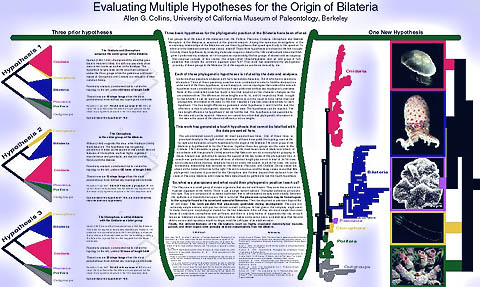COLLINS, Allen G., Museum of Paleontology and Dept. of Integrative Biology, University of California, Berkeley, CA 94720-4780

A great number of phylogenetic schemes relating the animal phyla has been offered during the last century. However, when one focuses on the base of these trees, there are just three basic hypotheses of relationship proposed for the basal clades of metazoans (i.e., poriferans, placozoans, cnidarians, ctenophorans and bilaterians). In each case, the poriferans and placozoans branch earliest. Hypothesis 1 places the bilaterians as the sister group to the ctenophores and cnidarians. Hypothesis 2 positions the bilaterians as sister to the ctenophores, whereas Hypothesis 3 places the ctenophores within the bilaterians; in both of these scenarios the cnidarians are basal. I have sought to falsify these three hypotheses by using molecular sequences of genes coding for the small ribosomal subunit 18S of 101 taxa. I performed three parsimony analyses where topology was constrained to match each of the above hypotheses and subsequently applied a topology-dependent permutation test (T-PTP) for each. All three hypotheses are falsified by this test. Moreover, I applied parsimony analysis without any toplogical constraints and generated an additional alternative hypothesis. This new hypothesis has the poriferans branching earliest, followed by the ctenophores, then the cnidarians. The placozoans and bilaterians form a clade that is sister to the cnidarians. These results suggest that the ancestral bilaterian may have resembled an adult placozoan rather than a larval cnidarian as implied by the three hypotheses above. Furthermore, the ctenophores may have independently evolved numerous characters often associated with more derived taxa.
75/125 YEARS